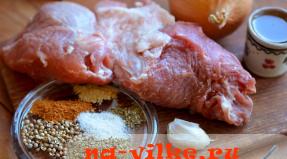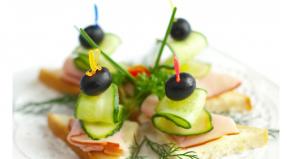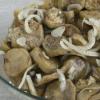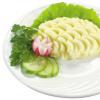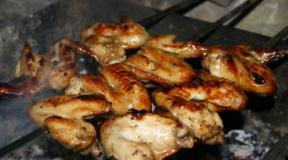Pickles for the winter without sterilization. Assorted vegetables for the winter
In the midst of the cucumber season, do not forget to cook in addition to the traditional salted or pickled cucumbers for the winter, a couple of jars of unusual, sweet and sour cucumbers, which are called “Pikuli”. The name pickles from cucumbers borrowed from the English "pickle", which means "pickle and pickle", are very rich, with a pronounced sweet-sour taste snack or as an additive in salads, a sandwich, shawarma or a hamburger. For busy ladies, as well as for those who do not like all kinds of pasteurization and sterilization, the pickle-cucumber recipe will be altogether received with a bang, because thanks to the high concentration of vinegar in the pot, it is not necessary to sterilize the jars. It's nice when delicious blanks are also fast!

Pikuli cucumber recipe:
- Usually, small cucumbers, onions, tomatoes, chives, cauliflower inflorescences are taken for making pickles, so if you have typical cucumbers for our latitudes, they are average (we always have such ones), just cut them in widths from 3 up to 5 mm. Choose cucumbers with a dense middle, no ripened seeds, otherwise cucumbers will not work so crispy and tasty.

- We clean two large onions and cut them into rings approximately the same width.

- Now we take a voluminous bowl so that all our vegetables can be well mixed for harvesting, put everything together - cucumbers, onions and sprinkle with salt.

- Knead, distribute salt in all cucumbers with onion rings.

- Cover with a plate and place it under some kind of pressure / load that is not too heavy or a liter jar filled with water. Leave the cucumbers and onions for 3 hours in this form.

- Exactly three hours later, let us lay everything in a colander and rinse off the salty liquid formed in a mixture of onions and cucumber slices.

- While the cucumbers will part with excess liquid - we will prepare a sweet and sour marinade based on apple cider vinegar. For the preparation of pickles, only natural vinegar — apple or wine — is recommended, because of its large amount in the marinade, ordinary table will be too tart. But apple cider vinegar is much softer, fragrant and its smell will not, as they say, “hit in the nose”. Note that the water in the marinade is not used. Pour in vinegar, add sugar, turmeric and peas allspice. If you want, you can add bay leaf, mustard seeds, fragrant herbs or nutmeg.

- Put the marinade on the stove and let it boil, trace the dissolving of the granulated sugar.

- Fill them with cucumbers with onions and let the marinade boil along with the vegetables.

- As soon as it boils, you can fold cucumbers in jars and pour marinade over the hangers.

- We seal the lids, turn over each jar and wait for cooling without a blanket. Pickles from cucumbers will be fully prepared only in a month, just then the taste of vinegar will fade into the background and disperse.
Vegetables
Description
Pickled cucumbers for the winter - This is a tasty and savory snack that will attract attention with its appearance and flavor. To prepare such a salad with your own hands at home is very simple and quick. He will surely please all housewives who love and welcome the preparation of pickles without sterilization.
Cucumbers contain a lot of useful substances that positively affect the human body. Eating them has a good effect on the motility of the digestive system, improves metabolism and speeds up metabolism, removing toxins. This, in turn, contributes to the strengthening of immunity and helps fight viruses and bacteria, as well as their metabolic products, which is especially important in the winter. In folk medicine, cucumber juice was used as a febrifuge. Useful cucumbers and the nervous system. A large amount of potassium helps to cope with the formation of kidney stones, and iodine contributes to the proper functioning of the pancreas. It is for these qualities, but also for low calorie cucumbers appreciate. They are a favorite vegetable of people leading a healthy lifestyle and adhering to the principles of healthy eating.
This preparation is perfectly preserved throughout the winter, the cucumbers in it remain firm and crispy, and when eaten they melt in the mouth. Your guests and households will certainly be interested in the taste of these young pickled cucumbers, because it is not at all like everyone else. By virtue of their variety and size, the pickles have sweet flesh, in which seeds are completely imperceptible. Try it on your own experience - and you will understand the difference! And we are waiting for your feedback.
The most inexperienced cookery mistress will cope with this task, and a detailed description of all the actions with step-by-step photos will help her in this, clearly showing the whole cooking process in trifles.
Ingredients
Steps
To prepare this salad, select the most beautiful and even cucumbers, the length of which does not exceed seven centimeters. Rinse them in running water and wipe dry. You will also need two onions, the size of which should not be larger than a large chicken egg. Peel the onions. Measure out the specified amount of salt, granulated sugar, vinegar and vegetable oil.

Cut cucumbers into circles, the thickness of which is equal to five millimeters, as shown in the photo.

Onions cut into two parts each, and then into half rings. Before shredding, place the product in water to remove caustic esters that irritate the eyes and cause tearing, which is especially important when using young onions.

Mix cucumbers and onions in a deep bowl.

Now salt the salad and mix well to dissolve salt crystals. Cucumbers at the same time begin to allocate juice.

Cover the salad like the one shown in the picture. Absolutely any heavy and clean object that does not absorb water can act as a cargo. Leave the design for three hours, placing the bowl of salad in a cool place. In the meantime, prepare jars and lids for them. Wash everything in warm water with baking soda and rinse to shine. Then steaming the jars or warm them in the microwave at full power for at least five minutes each, and boil the lids in boiling water for about two minutes. In the tin lids for seaming the machine there are rubber seals, so do not forget to remove them before immersion in boiling water. Rings return to its original place only after complete cooling of the metal.

After the specified time, drain the salted juice, discarding the cucumber-onion mass in a colander, as shown in the photo. After the excess brine is drained, rinse with assorted running water.

In the meantime, make a marinade: mix granulated sugar with natural apple or wine vinegar and vegetable oil. After that, add turmeric and add black pepper to the pea mass, and, if desired, pieces of crushed bay leaf. For the preparation of marinade choose a deep bowl with a thick bottom..

Heat the mixture over low heat or in a water bath until boiling. Marinade is considered ready as soon as the sugar in it is completely dissolved.

Now transfer to pickled pickles with onions and heat the salad until boiling.

Transfer the finished product in sterile jars. Place the platter tightly, gently pressing the salad down with a spoon. When all the cucumbers are laid out, divide the marinade into banks in equal parts..

Roll up the blank and turn the jars upside down, as shown in the photo. Delicious and sweet salad for the winter of the little cucumbers ready! Leave the pickles to cool in that position on the table. Wrap the workpiece is not necessary.Store ready-made cucumbers in a cold and well-ventilated room during the calendar year, and place the unopened jar of lettuce in the refrigerator, covering it with a nylon cover.

The first test with pickles, prepared for the winter, you can take only a month. Serve them just by putting them out of the jar in a salad bowl.

Enjoy your meal!
Still going to do the workpiece? Then this post is for you. Today’s recipe is a winter platter of vegetables or pickled pickles, and we’ll have not one, but two recipes: the choice (I didn’t choose, but made both, because I liked them in my own way).

“I make pickled pickles,” my friend said and showed me beautiful jars of mixed vegetables for the winter. There was nothing in these jars: besides tomatoes and cucumbers there were even pieces of apple and onions with garlic.
At my request to rewrite her recipe, she handed me a clipping from an old newspaper. “This is similar to the English word“ pickles ”- pickles,” I was surprised that the word had not been translated. But it turned out that everything was right there, and there is such a word in Russian. And that means it is assorted small vegetables. This tradition of pickles is characteristic of English cuisine, where it, in its time, came from India. In Europe, pickles are used more often for side dishes, and in the US - as a cold snack to hot drinks. Salty under strong, so to speak.
The pickles recipe that I got, adapted to our tastes. In English salting a lot of vinegar and they are sharp to our taste. And here is the recipe for our preferences.
For this vegetable platter, small vegetables will be needed, if possible: well, if you have cucumbers like gherkins, and tomatoes, cherry tomatoes. You will also need the smallest zucchini and tiny onion and small-small carrots. I tried to collect just such, but not everything turned out: I did not find gherkins, and the carrot in this form (tiny) is not for sale here.
The layout is given on 5 liter cans and vegetables are laid out in layers, so that one color alternates with another, and the jars themselves delight the gaze with their different colors. And when I made the recipe step by step, as recommended, I still had a lot of vegetables, and I took two more jars for them and repeated the recipe again. And what can I tell you: with large banks, the layers are clearer and everything fits.
(on 5 liter cans)
- 1-2 apples Antonovka
- 20 small cucumbers
- 20-25 small tomatoes
- 0.5 heads of cauliflower
- 3-4 ordinary carrots or 20 small ones
- 2 youngest zucchini
- 25 small bulbs
- 2.5 heads of garlic
- 4-5 bell peppers
- 5 celery stalks
- Dill and parsley stems
In each jar put:
- 1 bay leaf
- 1 bud of carnation
- 5 black peppercorns
Marinade on 5 liter cans:
- 2 liters of water
- 0.5 glasses of salt (100 g)
- 2/3 cup of sugar (120 g)
- 1 cup of vinegar (6%)
The longest in this story is the preparatory process. So, all the vegetables need to be washed. Peel carrots and cut into small pieces. Leave the washed squash with sandpaper and cut into small pieces too. Cauliflower disassembled into small inflorescences. Onions and garlic, too, to clean the skin. I had these small onions, and there was a lot of messing around with them. But I wanted to just that there were just small onions. My friend takes an ordinary onion and cuts rings - also good. So, after the first stage of preparation, all the components looked like this.


While they are "dipped" in boiling water, trim the edges of the cucumbers.

Yes, banks need to be sterilized and put on a clean towel.

And you can do greens. From dill and parsley only need to take the stems. Wash and cut them into pieces of 2-3 cm. We also need celery stalks with leaves. They can be washed and can not be cut.

Spread celery stalks and parsley fennel to the bottom of each jar.

And now you can fill the jars. So, the sequence in each bank we have is:
- - we start with a few pieces of Antonovka,
- - 4 cucumbers,
- - 4 tomatoes,
- - a handful of cauliflower blossoms,
- - a handful of carrot pieces,
- - a few pieces of zucchini,
- - 5 small onions (or several pieces of chopped rings)
- - 5 cloves of garlic
- - strips of bell pepper (I took the yellow and red)

Then put in each jar:
And make a marinade: boil all the ingredients except vinegar, and then add vinegar at the end and turn off the heat.

Pour the assorted vegetables in cans with hot marinade, cover them with lids and place them in saucepans for sterilization. Sterilize one-liter jars for 12 minutes (that is, 12 minutes after boiling water in a saucepan).

And at the end of the banks roll up, turn over, cover for a day, and then store at room temperature. And after two weeks you can already taste.

In the recipe, according to which I made this assorted vegetables, it is said that in order to improve the taste, it is possible to conduct “forced” cooling of the cans. That is, after you have the banks for 15 minutes "under the blanket", you need to get them, put them in a basin with warm water, and then gradually replace the water with cold one, put them under running water until the banks cool down completely. I did not suffer like this. But the idea is good, who are interested, you can try. That's just a lot of water is needed (the recipe says that the banks are cooled for more than an hour) Who counters - completely uninteresting.
And I wrote that when I started packing everything in liter jars, I have a lot of vegetables left. I had to use 3-liter and 1.5-liter tanks. And cook the marinade again. These two cans needed the same amount of marinade as 5 liter ones.

That's how they look the next day.
And another recipe
This vegetable platter is good for many vegetables from the vegetable garden. It is different in composition, but promises to be no less tasty. Alignment goes to the three-liter jar, which is very convenient. I would not recommend it to you in smaller banks: as a bit of everything, and the bank is full.

Well, let's get started?
(3 liter jar)
- 3-4 carrots
- 0.5 heads cabbage
- 1 small zucchini
- 1-2 bell peppers
- 1 large onion or 5-7 small
- 3-4 cloves of garlic
- 2-3 small beets
- 10-20 pods of green beans (I did not have)
For the marinade (5 liters of water):
Wash all the vegetables.
Carrots, beets cleaned from the skins. Pepper free from seeds, onions and garlic - from the husk.
Cut carrots lengthwise into four parts and put on the bottom of a sterilized jar.


Then - slices of zucchini and Bulgarian pepper, sliced as you like.

Then - onions in rings or whole heads, if they are small, and garlic cloves.

And on top of a tiny beet. If you do not have a small one, then you can cut one big one into four parts.
The recipe also provides for green beans, but this is not the season, so I do not have it in the bank.

When the pot is laid, you need to make a marinade. To do this, boil all ingredients without vinegar, add vinegar at the end. Pour marinade vegetables in a jar and sterilize for 30 minutes.

After sterilizing this platter, roll up the jars, turn over, and, as usual. Hold "under the blanket" day.
On the second day, the beets are colored like this. I think it's more beautiful: I love it when the cabbage is obtained with a beetroot hue. And now, traditionally on the balcony, I took a picture of my jar. I have a lot of Antonovs there now, so they hit the frame.

Appetizer promises to be savory.
Delicious blanks you!
And in order not to miss the new interesting recipe, subscribe to the e-mail blog updates.
This is the easiest recipe for canned vegetables, as for me. It is beautiful, varied and tasty. The ease of preparation is that nothing needs to be sterilized. And if you follow the recipe, it can handle even an amateur.
A lot of text. This is because I am writing in great detail. Cook faster and easier.
Firstly, we need banks under the covers, twists (these are those that are screwed on the can). The most convenient banks for 2 liters. But if the family is big, then it's better by 3. Some people use the same covers every year, but we prefer to buy new ones for each roll-in (this is more reliable).

I can not write the exact amount of vegetables, you will have it. In addition, the proportions of all different, different vegetables, this is an amateur. But you can easily check the amount of marinade in any scenario.
I used cucumbers, tomatoes, bell peppers, cauliflower, patissons, corn, carrots, onions and garlic (garlic required).
What else can be added to pickles? Zucchini, zucchini, green beans, white cabbage, radishes, apple-plums, celery root, young peas, pumpkin ...
You can, in general, take only cucumbers and tomatoes.
In addition to vegetables, you will need: horseradish leaves, cherries, currants, dry dill umbrellas and garlic (this is a basic set for pickling).
Plus for each jar - several peas of hot and fragrant pepper, bay leaf (you can add tarragon, a bud of dry cloves, a bit of mustard in the beans, at your discretion).
Now about the process itself. Wash cans and lids. Dry-wipe optional.
Soak cucumbers for an hour and a half in cold water (these brothers are capricious).
Wash, peel and prepare all vegetables.
I did not cook and blanch anything (if I had added green beans, I would have added it to half-cooked). Corn need to take those "sugar" varieties that are cooked quickly.
Cucumbers and tomatoes are better to take small. Carrots cut into strips or rings, corn and zucchini washers, Bulgarian pepper, petals, cauliflower disassembled into small florets. If the bulbs are large, cut into segments, small ones go whole. Garlic whole cloves. Large cucumbers can also be cut. If you want to add white cabbage, it is better to take a small one and cut it into quarters or eighths (so that they hold onto the stalk).
Put a pot of water to boil. If sooo rough, then on a 2-liter jar count half a liter of water (and then pour out too much).
In our washed jars we put the leaves of horseradish-currant-cherry on the bottom. On 3 peas of fragrant and hot pepper on each liter.
Then we spread the vegetables in random order - even in rows, at least mixed. Garlic is a must here! At the 2-liter jar, I had a head of garlic. From above we put umbrellas of dill.
When the water in the pot began to boil. Fill with boiling water all the cans to the top, put the lid on top (do not cheat, just put). Leave for 10-15 minutes.
After that, pour out of the cans all the water in an empty pan. Now we know how much marinade we need. At this stage, it would be good to measure the water (to calculate the salt-sugar-vinegar).
Again we boil this water and fill the jars for the second time. Again for 10-15 minutes.
Drain the water into the pan (jars of vegetables are covered with lids), now cook the marinade on it.
I measured salt and sugar with a measuring cup - not by weight, but by volume. Therefore, I will not write in grams, but in milliliters.
MARINAD (for every liter of water):
50 ml of sugar
45 ml of salt
110 ml of vinegar (9%)
That is, you multiply this amount by the number of liters in your saucepan.
No, not a lot of salt. No, it will not be too vinegar.
Add salt and sugar to the pan.
Immediately take a separate saucepan with the required number of lids, fill it with water and set it on fire (the lids should be sterilized in boiling water).
When the marinade with sugar and salt boils, add vinegar at the end. Again bring to a boil. And immediately fill in our banks with pickles. Immediately roll covers (who had time to lie in boiling water).

Turn the jars upside down, fold them somewhere in a corner (where they won't interfere), wrap them in a blanket and leave to cool completely. Then we turn over and store at room temperature (or in the storage room, cellar, what you have there).
After three weeks you can already try them. We specifically rolled up one liter jar for tasting.

My marinade has a tea shade, because I used brown sugar.

Vegetable or fruit platter marinated with special spicy vinegar is called pickles. Often, the term is used to designate pickled cucumbers, but this is not entirely correct - there are many recipes for preparing this preform, and many use other vegetables or vegetable mixes. Canned snack for a month, can be stored up to two years.
English pickled dish
Traditional English pickles are specially pickled vegetables or fruits (in English from the term “butter pickles” - pickles). The ingredients of the dish are cut in a special way and poured with a special brine with the addition of hot pepper and vinegar. The resulting product was used as an independent tasty snack or used as an additional ingredient in the preparation of steaks or other traditional dishes of English cuisine.
The main difference between pickles and traditional pickles is the use of special marinade based on specially prepared vinegar (insisted on mustard seeds and burning red pepper). He gives this snack a peculiar taste. In addition, in a classic recipe, all vegetables should be about the same size, or they are cut in a special way.
Story
In England, they began to pick pickles from the middle of the 19th century. It is believed that the marinade recipe was borrowed from Indian cuisine. Snack used to excite the appetite, as an addition to meat dishes and baked poultry. There are two types of traditional pickles - “chutneys” (vegetables are boiled before pickling until soft, smooth) and pickles, the ingredients of which are blanched, and then bottled with spicy vinegar sauce and spices.
Composition
Snack is prepared either from one type of vegetables or fruits (for example, from cucumbers, cabbage or apples), or from a vegetable mixture. The composition of different recipes include corn, beans and other legumes, tomatoes, carrots, gherkins, cauliflower, onions and garlic, greens. For the preparation of vinegar mustard mustard and pods of hot red pepper. Fruit pickles are prepared on the basis of pears, melons and other melons.
How to cook pickles
The answer to the question of how to cook the pickles correctly is contained in the secret of the special vinegar for the marinade. In ordinary vinegar add mustard seeds or mustard, chilli hot pepper, cumin, nutmeg (preferably hand-grated from the fruit). The mixture is poured into bottles of opaque glass and insist in a dark warm place for 15-20 days, occasionally stirring, and then used in pickling vegetables.
Pickle Cooking Recipes
For the preparation of pickles use vegetables of small, approximately the same size. Large root vegetables must be chopped, solid ingredients are pre-boiled or blanched. Some recipes are recommended to use a combination of fruits and vegetables, very tasty is obtained assorted apples, grapes, pears, zucchini and corn. Be sure to put the spices - allspice, turmeric, nutmeg.
Traditional recipe
- Time: 2 hours.
- Servings: 10 persons.
- Calorie dishes: 210 kcal.
- Purpose: for a snack.
- Cuisine: English.
- Difficulty: medium.
The classic recipe of pickles "in English", with a traditional set of vegetables, spices and spicy marinade. For cooking, take small vegetables, corn on the cob and a small head of cauliflower. If desired, corn can be replaced with lobio string beans. The average time of marinating the finished snack is 30 days. Prepare special vinegar in advance, it is infused for two weeks.
Ingredients:
- short-cucumbers - 5 pcs .;
- zucchini - 1 pc .;
- cauliflower - 1 small head;
- bulgarian pepper - 1 pc .;
- celery stalk - 1 pc .;
- onion - 2 pcs .;
- apple - 1 pc .;
- apple cider vinegar - 150 ml;
- sugar - 1 tbsp. l .;
- salt - 1 tbsp. l .;
- water - 0.5 l;
- mustard powder - 2 tbsp. l .;
- red hot pepper - 2 small pods;
- cloves, dill umbrella, black pepper - to taste.
Cooking method:
- Prepare the vinegar for the marinade: add the peppers and mustard powder to the apple cider vinegar, leave in a dark place for a week, then in an opaque dish for a week.
- Wash and slice all the vegetables and an apple into pieces of approximately the same size, the size of one medium cauliflower inflorescence (see photo below).
- Divide the cabbage into florets and blanch it in boiling water for 5-6 minutes.
- Combine all the vegetables in a large bowl, spread on prepared cans.
- Prepare the marinade - boil water, add the finished vinegar, salt, sugar and spices.
- Pour the marinade over the jars, pasteurize for 15 minutes, roll up the lids.

American style
- Time: 5 hours.
- Servings: 10 persons.
- Calorie dishes: 180 kcal.
- Purpose: for a snack.
- Cuisine: American.
- Difficulty: medium.
In the US, pickles are added to burgers and sandwiches as an additional ingredient, so they are prepared from small cucumbers with the addition of onions and bell peppers. Vegetables are rolled into jars and marinated for one week. Pre-heat treatment with this method of cooking snacks do not hold, before canning stand for several hours in cold water.
Ingredients:
- fresh cucumbers - 1 kg;
- onion - two large onions;
- granulated sugar - 0.5 kg;
- salt - 2 tbsp. l .;
- white wine vinegar - 0.5 liters;
- turmeric - 1 tsp:
- black pepper peas - 2 tsp;
- mustard seeds - 1 tbsp. l .;
- red pepper - 3 pods.
Cooking method:
- Prepare vinegar for the marinade: add the pepper and mustard seeds to the wine vinegar, leave in a dark place for a week, then in an opaque dish for a week.
- Prepare the vegetables: wash the cucumbers, wash and peel the onions, cut into thin half-rings.
- Put the vegetables in a bowl, pour in salt, cover with very cold water, leave in the refrigerator for 3-4 hours.
- Pour the prepared vinegar into the saucepan, add sugar and spices, bring the sugar to full dissolution, put the vegetables and let it stand on the fire for about a minute, not allowing the water to boil (see photo below).
- Spread on sterilized jars, close the lids.

With apples
- Time: 40 minutes.
- Servings: 4 persons.
- Calorie dishes: 250 kcal.
- Purpose: for a snack.
- Cuisine: Indian.
- Difficulty: easy.
When cooking pickles from a vegetable platter in many recipes, it is recommended to add an apple as an additional ingredient. In the presented fruit recipe, this fruit plays a key role. You can experiment with varieties, for example, you get a tasty snack based on autumn Chinese varieties of apples. This mixture is marinated faster than vegetable: the dish will be ready in one week.
Ingredients:
- apples - 3 pcs .;
- pears - 3 pcs .;
- plum or cherry plum, medium-sized, solid - 6-8 pcs .;
- apple cider vinegar - 150 ml;
- ginger root - 2 cm;
- granulated sugar - 200 g;
- fresh leaf of young peppermint - 3 pcs.
Cooking method:
- Prepare the fruit - wash, peel, cut into small pieces of equal size. Ginger Grate on a medium grater.
- Boil water, add all the ingredients, cook until sugar dissolves (see photo below).
- Arrange the mixture in the marinade in pre-sterilized jars, roll up the lids, remove in a cool place.

For the winter without sterilization
- Time: 60 minutes.
- Servings: 6 persons.
- Calorie dishes: 270 kcal.
- Purpose: for a snack.
- Cuisine: English.
- Difficulty: easy.
Traditionally rolled cans with spicy snacks are sterilized in the oven or in boiling water for 20–40 minutes. So the snack is stored longer, the risks of the appearance of pathogenic bacteria in it are reduced. A number of recipes propose replacing the sterilization of ready-made canned food with a scalding procedure of cans with pickles of boiling water. Then the same effect can be achieved with less time.
Ingredients:
- cherry tomatoes are red and dense yellow - 250 g;
- gherkins or cucumbers - 200 g;
- green beans - 70 g;
- sugar - 2 tbsp. l .;
- salt - 1 tbsp. l .;
- wine vinegar - 100 ml;
- red pepper - 2 pods;
- nutmeg - 1 tsp;
- turmeric - 1 tsp;
- allspice black peas - 0.5 tsp;
- carnation - 3 pcs .;
- garlic - 3 small lobules.
Cooking method:
- Prepare the vegetables - wash, clean the stalks.
- Blanch beans in boiling water for 3-5 minutes.
- Sterilize the jars, layered vegetables: tomatoes, cucumbers, beans, garlic, tomatoes.
- Fill with boiling water, leaving not filled 2-3 cm to cover. Add vinegar, spices, salt and sugar.
- Banks roll up; instead of sterilization, boil water 3 times. Clean in a cool place, after 10 days the snack will be ready.

Cabbage pickles
- Time: 120 minutes.
- Servings: 5 persons.
- Calorie dishes: 195 kcal.
- Purpose: for a snack.
- Cuisine: English.
- Difficulty: medium.
There are several recipes explaining how to make pickles from cabbage. Most of them suggest using cauliflower with the addition of another two or three vegetable ingredients. Before marinating the inflorescence must be boiled or blanched for 5-10 minutes. Red spicy pepper and nutmeg are offered as the main spices. Canned snack for 3-4 weeks.
Ingredients:
- cauliflower - 1 kg;
- large Bulgarian pepper, red and yellow - 3 pcs .;
- carrots - 2 pcs .;
- celery stalk - 2 pcs .;
- apple cider vinegar - 100 ml;
- red hot pepper - 2 pods;
- mustard seeds - 1 tsp;
- salt - 1 tbsp. l .;
- granulated sugar - 2 tbsp. l
Cooking method:
- Wash cauliflower, divide into florets. Boil in salted water (cooking time - 10 minutes), or blanch over boiling water until half cooked (5-7 minutes).
- Wash and peel the carrots, divide the peppers into halves, remove the core, wash the celery.
- Cut the vegetables to the size of a medium cabbage inflorescence.
- Mix vegetable assorted, spread on banks.
- Prepare the marinade: boil water, add salt, sugar. After acquiring a uniform consistency liquid, pour in the vinegar and pour in the spices.
- Pour the marinade in a pickle, spin the jars, sterilize in any way (in the oven, boiling water) for 20-30 minutes.
- Leave the appetizer to cool by wrapping cans in a warm blanket.
- Store cooled banks in a cool place. Pickles will be ready in a month.

